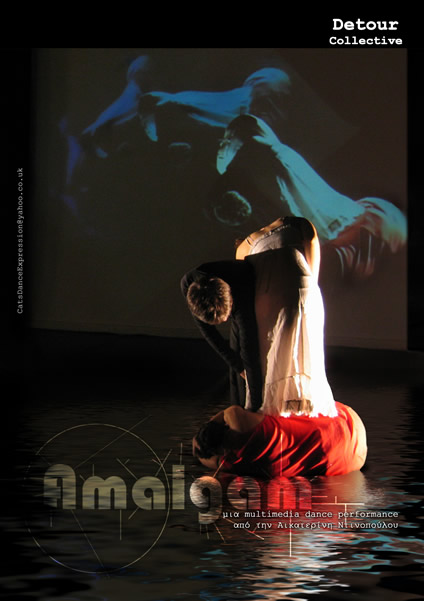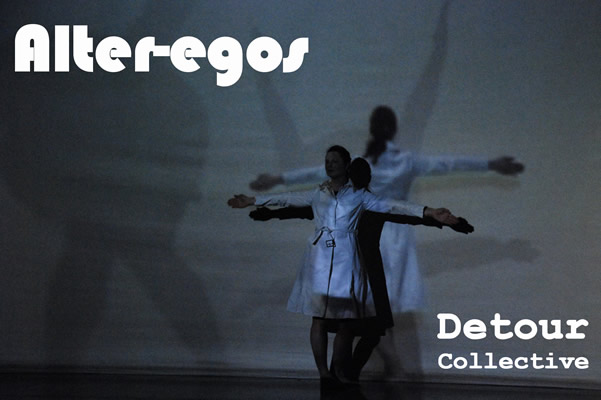biog
Caterini Dinopoulou is a performer, choreographer and video artist. She has presented works such as the digital performance Alter-egos, the interactive video installation 512:Personas, the multimedia dance performance Amalgam and the audiovisual live installation 2² in both England and Greece. The videos of the Amalgam performance have been awarded by the Video Art Gallery of London. She studied journalism. After an introduction to expressive dance and improvisation at Studio KER - Crete in 2000, she continued training in ballet and contemporary dance in Athens, where she also attended a foundation course on visual arts. She studied Dance and Visual Arts at the University of Brighton. In 2008, she was awarded a scholarship from the Alexander S. Onassis Public Benefit Foundation, which has allowed her to continue her studies with an MA in Performance: Dance Maker at the University of Chichester. She is delivering workshops on improvisation, performance and dance video in dance institutes in both England and Greece. She collaborates with the Creative Bridges Theater Company as choreographer and video artist. She is co-founder of Detour Collective aiming on the cultural development of Crete at the field of dance and visual arts.
performances
Amalgam (16 June, duration: 30 minutes)

Amalgam is a multimedia live performance that explores the complexity of the self using choreography, video projection and soundscapes. The performance walks a journey from juxtaposition to the fusion of the opposites within the self and based in a psychoanalytical context.
Jung’s psychoanalytic model of the self as the function that unites all the contradictions of human nature is a key influence for this performance. Archetypically, according to Jung, the persona represents the conscious reality and the role that one has in society; the shadow, on the other hand, represents both the unconscious and the imagination, hiding emotions and desires.
Amalgam expresses a visual and kinesthetic language to describe a psychological hypothesis through expressive dance movement and symbolic imagery. Parts of this language are the elements of mirroring, merging, balancing and scale the opposites; repetition, reverse and time of a cycle; optical illusions, approach to infinity, levels in relation to perspective and layering.
The continuous cycle of life is like a clock moving endlessly from birth to death. The withering is a reverse of blooming - the perpetual cycle of life within oppositions. The self receives and projects information to the environment as part of a non-stop circular process. In my work, the Self also is presented as both a video camera and projector where real and imaginary world co-exist. In Amalgam video camera and projector recreate this process.
By layering a video projection onto the performer an allegorical meaning is achieved revealing the relation between the physical and projected body. The projections of people with stereotypical roles and shadow images imply the immaterial world of memories and the unconscious. The physical body represent reality as tangible and present. The performer, by following a structure improvisation, interacts with the continuously imposed voices and images.
The performance engages the audience in the exploration of the concept of the self describing the development of personality through the social interaction and the internal impulses. The audience embrace the performers in an intimate way while all the diverse elements merge into an Amalgam.
company members
- Choreography, video artist and performance - Caterini Dinopoulou
- Music - Maria Papadomanolaki
- Live Digital Manipulation - Vernon Francis and Rosanna Tat
- Digital Performance - Marina Tsartsara, Konstantinos Baksalis, Maria Doukaki. Odysseas Doukakis, Mitch Birne, Stuart Davies, William Davies, Anna-Carina Mullins, Alex Mannion-Jones, Lori Oregan, Luke Powel, Pauline Smith, Caterini Dinopouou
Alter-egos (17 June, duration: 15 minutes)
Alter-egos is a digital performance that explores the concept of the complexity of the self using choreography, video projection, computer software and soundscapes. Through a visual and kinesthetic language, expressive dance movement and symbolic imagery, the performance describes the development of one’s personality both inside the social interaction and the internal impulses. Alter-egos is an interdisciplinary work where real and imagined world co-exist as digital bodies interact with the physical body of a dancer not only as a reflection but also as an alter-ego.
The shadows of the dancer also become part of the choreography. The choreography has developed through structured improvisation. The movement vocabulary of the choreography includes both pedestrian movement and expressionistic dance. An animalistic movement focuses on the exploration of unusual forms. The mechanical repetitive movement of the dancer – that implying the rhythm of a contemporary metropolis – meets the motion qualities of digital editing software such as play, pause, rewind, fast forward, slow motion, copy/paste and escape.

In addition, the performance based on the research of philosophical models and psychological hypothesis. Carl Jung’s assumptions on collective unconscious archetypes and symbolisms of myths have been the key inspiration of Alter-egos. To be more precise, the performance describes the archetypes of “Persona” as the conscious reality and the roles that each one has in the society – “Shadow” that reviles internal impulses as reflecting unconscious emotions and desires – “Self” as the function which unites all the contradictions of human nature. Further research approaches the impact of duality in contemporary culture and discusses phenomenology of presence/absence.
Alter-egos is a dance theatre performance that uses digital media such as video projections that interact physically with the dancer defining a surreal and cinematic aesthetic. Digital media introduce new art genres by combining multiple disciples so they could expand the expressive possibilities of a dancing body to other art forms.
company members
- Choreographer and Artistic Director- Caterini Dinopoulou
- Sound Composer and Lighting Designer - Vernon Francis
- Physical and Digital Performer - Rosanna Tat